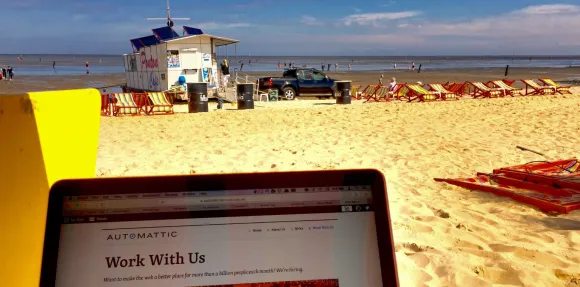The Importance of Remote Work and its Potential as an Equalizer

In the grand scheme of things, remote work is still a relatively new phenomenon. This is easy to forget when it’s part of one’s everyday life — which is why it’s all the more important to remind oneself that nobody has it figured out perfectly yet.
People and organizations are still experimenting — succeeding, yes. But also: struggling. Failing. We’re all exploring and negotiating the future of work.
But still, a few things have emerged.
The Rules of Remote
In general, you’ll want to optimize for asynchronous communication.
Time zones are the obvious constraint — but personal life circumstances will also influence what times people will be able to work, or take calls, or respond to messages. At Automattic, we use WordPress blogs with the P2 theme for this. Every team has their own blog to post updates, plans, and decisions to.
That works well. But it’s hard to build trust between colleagues like that. That’s why we’re also making time for true synchronous time. Not necessarily for making decisions or planning or writing code — even though that could be the superficial purpose of a call or a real-life meeting.
The underlying value of synchronous time — ideally it’s a bit undirected, too — is to get to know one another better, to understand each others’ jokes, to learn to notice when someone is confused — to build trust. Pair program, group design — or just have a meal together in a video call. Experiment.

A meta rule that I learned early on is that you have to over-communicate — write down, make explicit, and say more than you think would be reasonable. It’s likely that that amount, then, will be just right.
But in remote work, nothing is decided yet. Even this rule will evolve over time: we will learn how to make work more visible again. Right now, much of it is a conscious effort — after all, we’ve only just moved to working through screens. People use practices like Kanban to indirectly communicate what is happening at work.
This can only be the beginning, though — we need to make work even more visible, and it needs to be even more automatic, more relevant, and easier to filter and consume.
And that’s just one aspect that we need to make better.
As makers of digital products we’re in a very special position. We create the tools that help us work together — and how we shape our tools will also influence how we will work in the future.
An Emerging Role of Remote Work
This is an interesting and wonderful position to be in, but it also comes with lots of responsibility.
Some people might associate remote work with a nomad lifestyle, with pictures of laptops on beaches. And that’s certainly an interesting facet.

But it’s just one angle to look at it.
Remote work is an important shift in how our society operates, in that it opens doors for many who weren’t able to walk through them before.
People who cannot afford to move where all the work is, people who cannot adhere to a traditional 9-5 workday because they care for their families — remote work is already creating lots of new opportunities for these people, and this effect will only grow stronger.
Remote work is an equalizer.
To make these benefits accessible to more and more people, it takes conscious effort to evolve work itself.
In Project A3, eight AGI design legends are creating visual designs for the web — together with high school students in Paintsville, Kentucky and designers at Automattic.

It’s an all-remote collaboration that spans the world.
Appalachia is not a hot bed for jobs in technology — but with remote work, it doesn’t have to be. With remote work, high school students can learn and make a living and gain new hope for the future.
I’m excited and proud to be working with a company that is actively trying to shape the future of work. And that’s just one example.
Of course, remote work isn’t the best choice for everyone, and it doesn’t have to be. It can’t provide all the benefits to all the people — but it has helped many already. It’s making a difference. And it can help many others in the future.
Getting Started
Interested in remote work? Find the people who make it work and reach out. Send me an email — I’m happy to help if you have any concrete questions that I can answer. Join Slack communities — Remotive is a large one and very welcoming.
Even if you have no plans to work remotely — the things we learn and the improvements we make to how work works have value regardless. Many people working in offices today stare at screens all day. They work together through computers even when they’re in the same building. Any improvements in processes, practices, and tools will benefit them as well.
It’s just that for remote workers, the need to improve things is a bit more pressing.
If you invest in technology companies — make a conscious effort to push remote work. It’s a huge advantage in hiring — remote companies have access to a talent pool that is much larger than it would be in any major city. Not only that: it’s also much more diverse. And diverse teams are winning teams.
If you’re a founder — reach out to remote-friendly investors:
Researchers — this thing is still developing. Do studies, document what is happening, but also — figure out how to make it better. Your contribution could have a meaningful impact on someone’s life. We need better tools, better processes, better organizations.
Fellow remote workers — it’s on us to make sure that work keeps getting better for everyone. We can have a positive impact on so many lives. Reflect on your work. Learn. Improve. And share with others. Blog about it. Be a mentor. Nudge people. Have an open door.
Let’s make remote work better and better — not only because it gives people more freedom or because it’s a competitive advantage — but because it can give people back their hope.